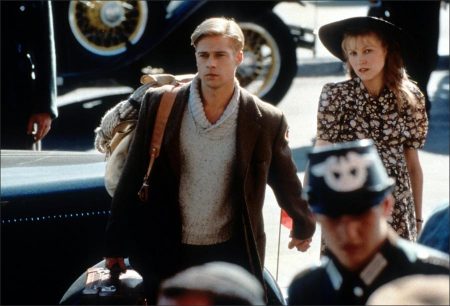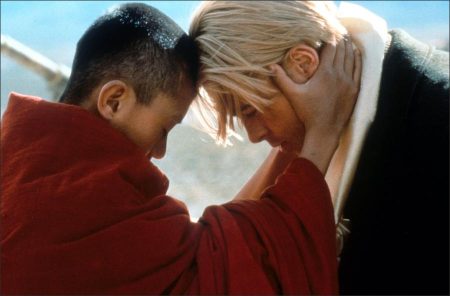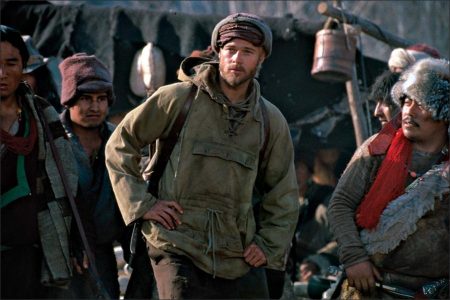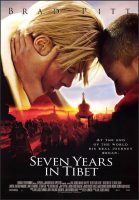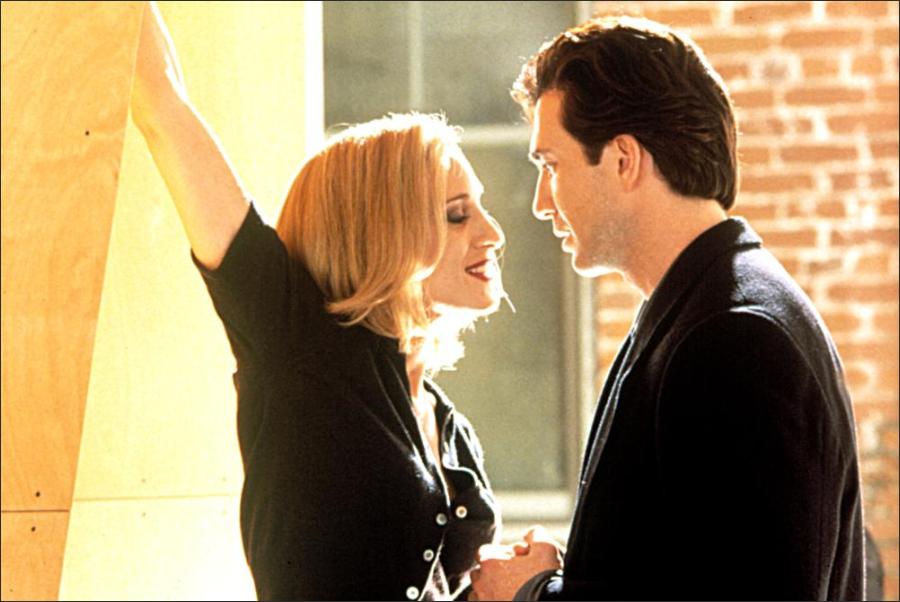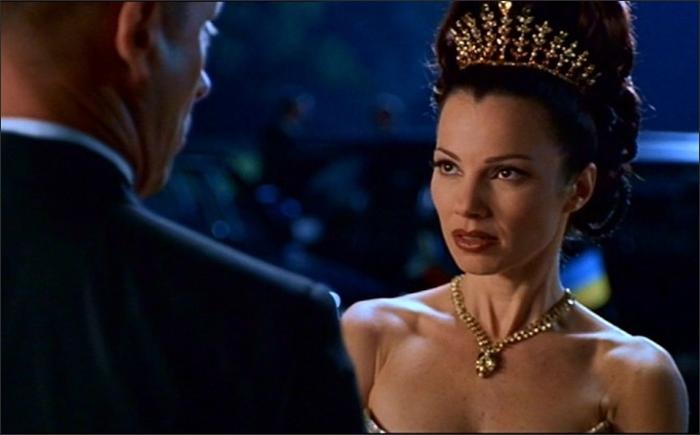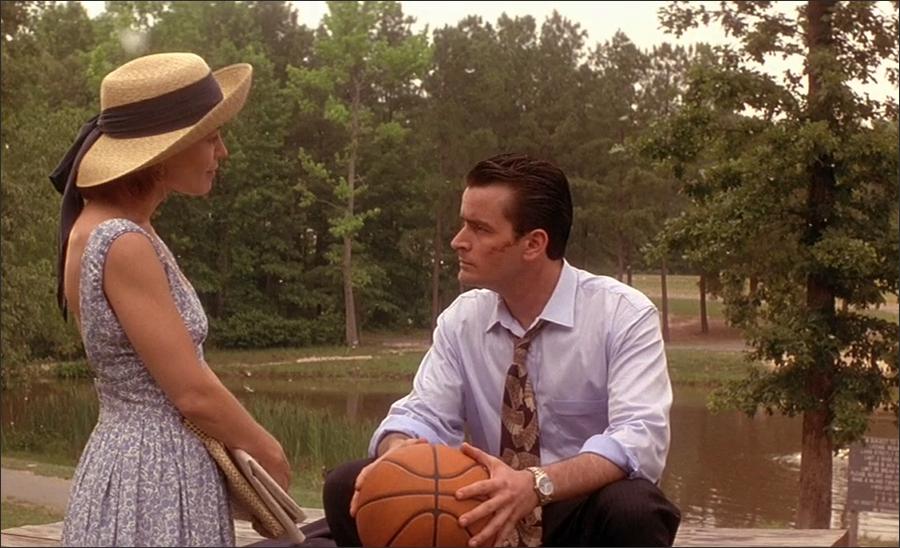Taglines: At the end of the world his real journey began.
Seven Years in Tibet movie storyline. After the death of 11 climbers, Austrian Heinrich Harrer (Brad Pitt) decides to add glory to his country and to the Austrian pride by climbing Nanga Parbat in British India, and leaves his expectant wife behind. An egoist and a loner, he does not get along with others on his team – but must bend to their wishes after bad weather threatens them.
Then WWII breaks out, they are arrested and lodged in Dehra Dun’s P.O.W. Camp. He attempts to break out several times in vain, but finally does succeed along with Peter Aufschnaiter (David Thewlis), and they end up in the holy city of Lhasa – a place banned to foreigners. They are provided food and shelter, and Peter ends up marrying a tailor, Pema Lhaki, while Heinrich befriends the Dalai Lama.
They meet regularly; while he satiates the child’s curiosity about the world, including Jack the Ripper and ‘yellow hair’; he is exposed to the teachings of Lord Buddha, He even constructs a movie theater, while getting news of the end of the war, his divorce, and his son’s refusal to communicate. But nothing will prepare him for the devastation about to descend when Communist China decides to attack, leading to the deaths of over 1 million Tibetans, the destruction of over 6000 monasteries, and betrayal from their very own people.
Seven Years in Tibet is a 1997 American biographical war drama film based on the 1952 book of the same name written by Austrian mountaineer Heinrich Harrer on his experiences in Tibet between 1944 and 1951 during World War II, the interim period, and the Chinese People’s Liberation Army’s invasion of Tibet in 1950. Directed by Jean-Jacques Annaud and starring Brad Pitt and David Thewlis, the score was composed by John Williams and features cellist Yo-Yo Ma.
Most of the shooting took place in Argentina, in the city of La Plata (the railway station where Heinrich leaves for Unserberg is the Main Train Station of La Plata, for example), and in the Mendoza Province, in such places as the Andes mountains. Some time after the film’s release, director Annaud confirmed that two crews secretly shot footage for the film in Tibet, amounting to approximately 20 minutes of footage in the final film. Other footage was shot in Nepal, Austria and Canada.
Film Review for Seven Years in Tibet
Jean-Jacques Annaud’s “Seven Years in Tibet” takes the true story of a bright and powerful young boy who meets a stranger from a different land and buries it inside the equally true but less interesting story of the stranger. The movie is about two characters and is told from the point of view of the wrong one.
As it opens, we already understand or guess much of what there is to know about Heinrich Harrer (Brad Pitt), an Austrian obsessed by mountain climbing. We know next to nothing about the early life of the Dalai Lama, the spiritual leader of Tibet. We know all about the kinds of events that occupy the first half of the movie (mountain climbing, POW camps, wilderness treks). We know much less about the world inside the mysterious Tibetan city of Lhasa, where lives a 14-year-old boy who is both ruler and god.
“Seven Years in Tibet” is an ambitious and beautiful movie with much to interest the patient viewer, but it makes the common mistake of many films about travelers and explorers: It is more concerned with their adventures than with what they discover. Consider Livingstone and Stanley, the first Europeans to see vast reaches of Africa, who are remembered mostly because they succeeded in finding each other there.
Vienna, 1939. Harrer is preparing an assault on the difficult Himalayan peak of Nanga Parbat. War is about to break out, but he is indifferent to it, and cold to his pregnant wife (“Go–leave! I’ll see you in four months!”). He and a guide named Peter Aufschnaiter (David Thewlis) are soon on the peaks. The mountain-climbing scenes (shot in the Andes) are splendid but not very original; Heinrich saves Peter despite a broken ankle, they are nearly killed by an avalanche, the war begins, and they’re interred in a British POW camp, from which they finally escape.
This material occupies the first half of the movie, and yet strictly speaking it has nothing to do with it. The story proper (the seven years mentioned in the title) begins after they stumble into Tibet and are welcomed uncertainly by the peaceful and isolated civilization they find there.
From the moment of the first appearance of the Dalai Lama, the film takes on greater interest. He stands on the parapet of his palace in Lhasa and surveys his domain through a telescope. He is fascinated by the strangers who have arrived in his kingdom, and soon sends his mother to invite Harrer to visit.
“Yellow Head,” he calls him, touching the European’s blond hair with fascination, and soon protocol falls aside as he asks Harrer to build him a movie theater, and teach him about the world outside. This makes an absorbing story, although I suspect the relationship between pupil and student did not feel as relaxed and modern as it does in the film. Aufschnaiter, the guide, meets a local woman tailor (Lhakpa Tsamchoe) and marries her, and we gather from soulful looks that Harrer would have liked to marry her himself, but the Harrer character is not forthcoming.
Brad Pitt plays him at two speeds: Cold and forbidding at first, and then charming and boyish. He might have been more convincing if he’d been played by, for example, Thewlis. But “Seven Years in Tibet” is a star vehicle: Pitt is required to justify its $70 million budget, and it would be churlish to blame him for his own miscasting since the movie would not have been made without him. The film shows the behavior of the Red Chinese toward Tibet as cruel and gratuitous. Why the Chinese so valued this remote kingdom is a mystery; maybe it was a threat to self-righteous, lockstep Marxism. The film shows how Tibet was betrayed from without and within, and then the Dalai Lama, now 21, flees into long years of exile.
He has a more complex face for me, now that I have seen the torturous journey from his childhood. I wish I had learned more about Tibet: What were the ethnic ramifications, for example, of the marriage between the tailor and the mountain climber? How easily was the language barrier overcome? Why were the Dalai Lama’s advisers willing to allow him to come under the influence of a foreigner? How did the boy overcome his godlike upbringing to become open and curious to the outside?
These questions are not exactly answered. But the film does deal with one issue that has been publicized recently: The fact, unknown to the filmmakers when they began, that Harrer had been a Nazi party member since 1933. Voice-over dialogue establishes him as a Nazi early in the film, and another line later says he “shuddered to recall” his early errors. The information about Harrer should have come as no surprise; would the Nazis have risked letting a non-party member win the glory of conquering Nanga Parbat?
Seven Years in Tibet (1997)
Directed by: Jean-Jacques Annaud
Starring: Brad Pitt, David Thewlis, B. D. Wong, Mako, Jamyang Jamtsho Wangchuk, Lhakpa Tsamchoe, Jetsun Pema, Danny Denzongpa, Ingeborga Dapkunaite, Ama Ashe Dongtse
Screenplay by: Becky Johnston
Production Design by: Hoang Thanh At
Cinematography by: Robert Fraisse
Film Editing by: Noëlle Boisson
Costume Design by: Enrico Sabbatini
Set Decoration by: Jim Erickson
Art Direction by: Claude Paré
Music by: John Williams
MPAA Rating: PG-13 for some violent sequences.
Distributed by: TriStar Pictures
Release Date: October 8, 1997 (United States), November 21, 1997 (United Kingdom)
Hits: 263
